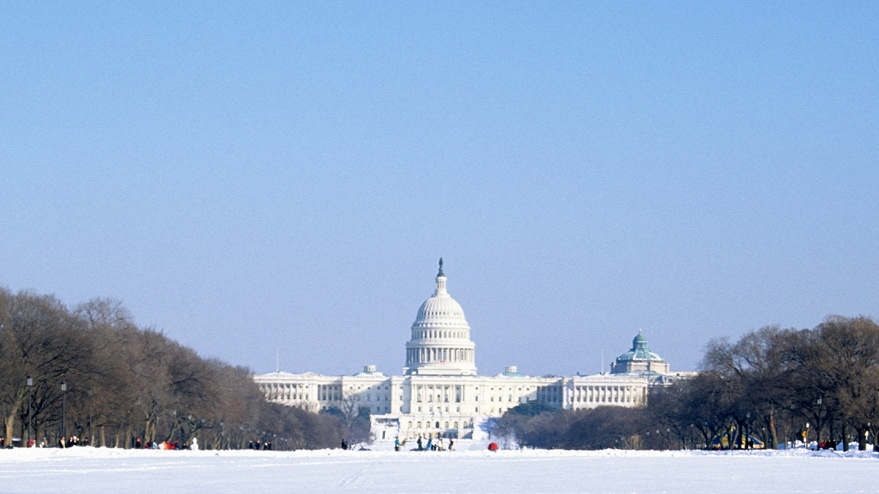Consider this unintuitive fact: global and US emissions declined more quickly in the first Trump presidency than during the Biden presidency.1 Several global factors account for this phenomenon, such as decreased emissions during the COVID-19 pandemic and increased emissions from record-breaking forest fires in the past two years.

It may be tempting—although incorrect—to conclude that the US presidential election is therefore immaterial in accelerating the transition to net zero. It’s likewise hyperbole to assume that climate change will disappear from the global agenda under a second Trump presidency. For Canadian companies and financial institutions, navigating climate change and sustainability in the second Trump presidency may require a more nuanced consideration of the likely impacts.
The climate continues to change—and more quickly than expected
Simply put, global emissions are expected to be significantly higher under the second Trump presidency than would have been under a continuation of Biden’s policies or a Harris administration, based on Trump’s stated policy positions like ending the Inflation Reduction Act (IRA) or reducing environmental regulations. While investments made during the Biden presidency, such as renewable energy projects supported by the IRA, are expected to contribute to an overall continued decline in emissions from the US, the pace of that reduction is expected to slow. Further, the expected US withdrawal from leadership positions or even participation in global climate efforts is likely to have a negative impact on the pace of emissions reductions globally. There are two important changes for Canadian companies and investors as a result:
The physical impacts of climate change
A decrease in the pace toward net zero will likely result in an increase in the intensity, frequency and severity of climate-change-driven extreme weather between now and 2030. This could also push the planet past environmental tipping points, which would unleash the more catastrophic physical impacts of climate change. These impacts would be felt in businesses’ operations on Canadian soil, but also through supply chains and investments abroad. Increased physical impacts of climate change is an unfortunate but safe bet for the long term, and should be a top concern of boards, insurers, pension plans and other long-term investors. Shorter-term impacts may be felt by Canadian businesses through changes to insurance coverages and increased due diligence of physical risks in transactions.
Preparing for the emergency brake economic scenario
Many companies and investors are using different future scenarios to plan for climate change. These include a net-zero scenario, where investments in renewables and electric vehicles move more quickly, and a business-as-usual scenario, where we transition much more slowly to a lower-emissions economy. In between those lies the so-called emergency brake scenario. In this projection, emissions rise in the short term, leading to extreme physical impacts, which in turn prompt governments and civil society to sharply pivot toward net zero. The emergency brake scenario would be the worst case for many investors. They would be left with stranded assets, a shortage of supply and higher costs for critical minerals and other inputs to low-emissions goods, significant policy change, likely increases in public borrowing and other sharp transition impacts.
Greenhushing and a fragmented world
One of the safest bets for climate change under the incoming Trump administration is a cancellation of the US Securities and Exchange Commission’s (SEC) proposed climate change disclosure rule.2,3 This would have forced dual-listed Canadian companies to disclose their emissions and their climate strategy. While many businesses will breathe a sigh of relief—the proposed rule was 885 pages—this change will likely provide only a brief reprieve in their climate-related reporting requirements:
Disclosure delays—but the train has left the station
Several states, most notably California, have put in place or are developing climate-related disclosure requirements. It's unclear how Canadian securities regulators will respond to the all-but-certain end of the SEC rule, although there could be some delay—even indefinitely—to the implementation of proposed sustainability reporting rulesOpens in a new window in Canada. Taken together, some Canadian companies may have more time to comply. But overall, the train has left the station. Many regulators have implemented disclosure rules, including at the US state level and in Europe, Australia, Hong Kong and the Office of the Superintendent of Financial Institutions here in Canada. Canadian companies should get ready for eventual climate-related disclosures, taking advantage of any delays resulting from a change to the SEC’s plans.
States and cities, and a fragmented world
One of the most significant challenges facing Canadian companies operating in the US is the coming fragmentation between the US federal government and other jurisdictions, including state and municipal authorities within the US. For example, a Canadian company bidding to be a supplier to the State of California may be required to share its green credentials, such as having a net-zero target. Yet the company may be excluded from working with a federal US client on the same basis. Canadian companies will need to be intentional with how they navigate a fragmented policy context within the US, between the US and Canada and between the US and other jurisdictions, such as Europe. This is often referred to as “greenhushing,” which is the practice of continuing to advance climate strategies without shouting too loudly about them.
Organizational psychology
An overlooked, but important, impact of the incoming presidency is on the organizational psychology related to climate change, such as: How are climate or sustainability leaders motivated or rewarded? Are climate skeptics emboldened in meetings or workplace culture? Does climate change get pushed down the web page or pushed down the board agenda? How will greenhushing affect employee recruitment and retention?
What Canadian companies can do next
The climate is still changing. And these changes are likely to accelerate as a result of the US election. This adds even more urgency for companies to adapt and prepare for further disruption to their operations and supply chains caused by the severe weather patterns they’re already experiencing.
Companies need to balance the incoming presidency, which is a very real headwind to climate action, with the need to maintain an appropriate focus on climate within key functions, including enterprise risk management, procurement, insurance, capital planning, investor relations and transactions. Management teams and boards would also do well to consider how the future US administration may affect their approach to managing climate-related business risks and opportunities. They can do so by focusing on the following actions:
Reassess climate change targets
Given the slower pace of decarbonization expected in the broader economy, achieving emissions reductions in Scope 2 and certain Scope 3 categories, such as purchased goods and services or financed emissions, will be more challenging than companies may have thought three to five years ago. At the same time, regulatory requirements have increased companies’ accountability for disclosing targets that were previously voluntary disclosures. With such substantial changes in the economy and in regulation, companies should reconsider their targets and commitments to make sure they are closely linked to corporate strategy, capital allocation and risk management.
Pinpoint the physical risks in your supply chain, the markets in which you operate and the resources you rely on
We’ve researched how climate change-driven heat stress and drought threatens the production of essential commoditiesOpens in a new window around the world. As climate disruption intensifies, it’s critical for companies to understand where these risks exist in their supply chains and develop adaptation strategies. This may involve investing in new technologies to reduce reliance on affected commodities.
Prepare for the unexpected
President-elect Trump may use executive orders once in office to advance his agenda.4 Companies can use scenario analysis to evaluate the potential impact of these orders and other regulations on their business. They can also reassess their climate-related principles—such as their commitment to net zero in the long term—to anchor their climate strategies through a fast-changing regulatory and economic context.
Take a deeper dive into our US election analysis series
Interested in how the US election results may affect your organization?
1 “Greenhouse Gas Emissions from Energy Data ExplorerOpens in a new window,” International Energy Agency, last updated August 2, 2024.
2 Andrew Ramonas and David Hood, “SEC Poised for Slow Regulatory Unraveling Under Trump: ExplainedOpens in a new window,” Bloomberg Law, Nov. 7, 2024.
3 “Our Take: PwC’s Financial Services Update,” PwC US, November 15, 2024.
4 Peter Nicholas, Matt Dixon and Carol E. Lee, “'Like nothing you've seen': Trump team readies a flurry of executive actions for Day 1Opens in a new window”, NBC News, Nov. 21, 2024.
Contact us


Partner, National Sustainability Report and Assurance Leader, PwC Canada
Tel: +1 604 806 7123

National Sustainability Strategy and Transformation Leader, Global Sustainability Leader for Enterprise Private Business, PwC Canada
Tel: +1 587 226 1303




















